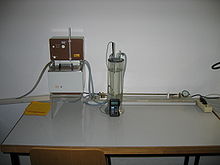Dilatometer
Dilatometers ( Latin dilatio = extension) are measuring devices for measuring the expansion of a sample.
The most common type is the thermal dilatometer , which are measuring devices for measuring the linear thermal expansion of a sample as a function of temperature. The thermal expansion is reacted a measure of how the volume of a body to changes in temperature. Thermal dilatometers are used, for example, in quality assurance and the development of sintered products and in basic research.
Structure and types
Depending on the way in which the expansion is measured, different types are distinguished. The most common thermal dilatometers are:
- Capacitance dilatometers have a parallel plate capacitor with a movable plate (distance sensor). Here, measurement accuracies in the picometer possible.
- Push rod dilatometers consist of an oven, the sample holder and the unit for recording and evaluating measured values. The sample is located in a tube made of quartz glass or ceramic. It is firmly connected to a rod that transmits the change in length of the sample for recording the measured values. Since the measuring system (support, push rod) is also exposed to the same temperature as the sample, and thus also expands, it is not a direct measurement, but a relative value that has to be converted afterwards.
Thermal dilatometers consist of a heat source, such as an oven (temperatures from −260 ° C to 2000 ° C are common), with which a certain temperature profile (rising temperature, constant temperature, changing temperature, and so on) can be set. For simpler measurements in a temperature range from 0 ° C to 100 ° C, thermal dilatometers are used in which water is heated and passed through or over the sample. If you want to use it to measure the linear expansion coefficient of a metal, for example, you take a pipe made of the corresponding material and run hot water through it. The pipe warms up to the temperature of the water and you can easily determine the relative expansion depending on the water temperature.
A large glass vessel filled with water is used to measure the thermal volume expansion of liquids. Inside there is an expansion vessel (glass container with an exact volume scale) with the sample liquid. If the water is heated, the sample liquid expands and the volume read changes. However, here too, the expansion of the sample vessel must be taken into account and calculated.
The expansion or expansion coefficient of gases cannot be measured in this way, since the pressure also plays a role here . A gas thermometer is suitable for such measurements .
See also
literature
- Hans Lehmann, Horst Gatzke: Dilatometry and differential thermal analysis for the assessment of processes , Hermann Hübener Verlag, Wilhelmshaven, 1956
- T. Barron: Generalized theory of thermal expansion of solids ASM, 1998
- A. Pippard: The Elements of Classical Thermodynamics Cambridge University Press, Cambridge (England), 1968
